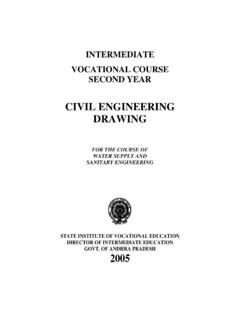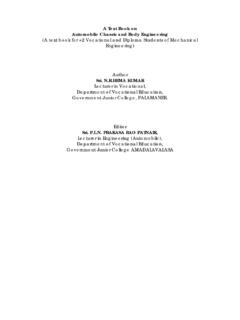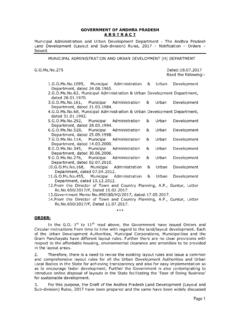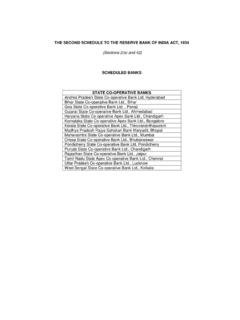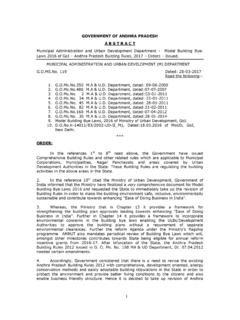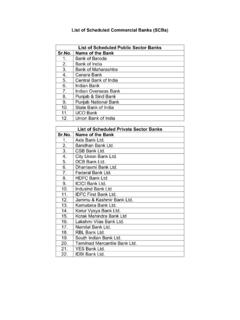Transcription of BUILDING MATERIALS & CONSTRUCTION
1 INTERMEDIATE VOCATIONAL COURSE SECOND YEAR BUILDING MATERIALS & CONSTRUCTION FOR THE COURSE OF WATER SUPPLY AND SANITARY ENGINEERING STATE INSTITUTE OF VOCATIONAL EDUCATION DIRECTOR OF INTERMEDIATE EDUCATION GOVT. OF andhra pradesh 2006 Intermediate Vocational Course, 2nd Year : BUILDING MATERIALS and CONSTRUCTION (For the Course of Water Supply and Sanitary Engineering) Author : Sri P. Venkateswara Rao & , Editor : Sri L. Murali Krishna. State Institute of Vocational Education andhra pradesh , Hyderabad. Printed and Published by the Telugu Akademi, Hyderabad on behalf of State Institute of Vocational Education Govt. of andhra pradesh , Hyderabad. First Edition : 2006 Copies : All rights whatsoever in this book are strictly reserved and no portion of it may be reproduced any process for any purpose without the written permission of the copyright owners. Price Rs: /- Text Printed at.
2 andhra pradesh . AUTHOR Puli Venkateshwara Rao, (STRUCT. ENGG.) Junior Lecturer in Vocational, WS & SE Govt. Junior College, Malkajgiri, Secunderabad. & M. VISHNUKANTH, (Civil) Junior Lecturer in Vocational, WS & SE Govt. Junior College, Huzurabad, Karimnagar Dist. EDITOR L. MURALI KRISHNA, ( ) Junior Lecturer in Vocational, CT Govt. Junior College, Ibrahimpatnam, Ranga Reddy Dist. WATER SUPPLY AND SANITARY ENGINEERING IVC SECOND YEAR BUILDING MATERIALS & CONSTRUCTION STATE INSTITUTE OF VOCATIONAL EDUCATION DIRECTOR OF INTERMEDIATE EDUCATION GOVT. OF ANDHRAPRADESH REFERENCE BOOKS 1. BUILDING MATERIAL - RANGAWALA 2. BUILDING MATERIAL - SUSHIL KUMAR 3. BUILDING MATERIALS & CONSTRUCTION - 4. BUILDING CONSTRUCTION - 5. BUILDING MATERIALS - MODEL PAPER BUILDING MATERIALS AND CONSTRUCTION Time : 3 hrs Max Marks : 50 SECTION A Note: 1) Attempt all questions 2) Each question carries 2 marks 10x2=20 1.
3 Name any four important stones used in the BUILDING CONSTRUCTION 2. What are the advantages of refracting bricks? 3. What is meant by bulking of sand? 4. Define compaction of concrete 5. Name any four wood based products 6. Define bearing capacity of soil 7. What are the uses of adhesives? 8. What are the important sources of dampness? 9. What are the uses of stone masonary? 10. What are the advantages of floors? SECTION B Note: 1) Attempt any five of the following 2) Each question carries 6 marks 5x6=30 11. Explain geological classification of stones 12. Explain the quantities of good brick 13. Explain the preparation of cement mortar 14. Explain the following 1. Curing of concrete 2. Uses of steel 15. Explain the CONSTRUCTION of flat roof madras terrace roof 16. Explain the functions of structural components of BUILDING 17. Explain the defects in timber 18. Explain different types of cement * * * CONTENTS Chapter Name of the chapter No.
4 Of Pg. No. No. periods 1. Stones 10 1 2. Bricks 10 16 3. Cement 10 43 4. Sand 10 54 5. Mortar 09 60 6. Concrete 10 70 7. Timber 09 80 8. Miscellaneous BUILDING MATERIALS 20 95 9. Types of Buildings 05 120 10. Foundations 15 132 11.
5 Masonry 05 156 12. Floors 07 194 13. Roofs 10 208 14. Damp proof & Fire proof CONSTRUCTION 07 233 MODEL PAPER REFERENCE BOOKS INDEX INDEX A Appliances for lifting stones Ashlar masonry B Bearing power of soil Black cotton soil Bonds in brickwork Brick masonry Brick Partitions Built-up sections Bulking of sand Buttresses C Causes of dampness Cavity walls Cement concrete CONSTRUCTION Cement concrete piles Composite floors Composite masonry Concrete mixers Concrete sheet piles Cost of formwork Curing of concrete Curved roofs D Damp proofing Dead load Doors and windows Double roofs Drainage of pitched and flat roofs Dressing of stone surfaces E Earth rammers Effects of dampness External finishes F Fire protection in buildings Fire protection systems Floors and floorings Footings Formwork Foundations for machines Framed structures G Grading of aggregates
6 Grillage foundations Group of piles Guniting I Increasing the bearing power of soil J Joints in stone masonry Junctions K King-post truss L Lightweight concrete Live load Load bearing piles Loads on foundations M Method of dropping a weight Methods of damp-proofing Methods of sound insulation Methods of timbering O Objects of foundations Ornamental brickwork P Partitions Piers Pile foundations Pile hammers Pitched roofs Plastering Pointed arch Pointing Pre-cast concrete Proportioning concrete Purlin roofs Q Quality control of concrete Queen-post truss Quoins R Raft foundations Reinforced brickwork Retaining walls Roof coverings for pitched roofs Roofs Rooter Round bars Rubble masonry S Sand piles Scaffolding Screw piles Shoring Single roofs Stairs Stone masonry Structures in brickwork T Timber floors Timber piles Timber sheet piles Tools used in brick masonry Tools used in stone masonry Trussed roofs Types of floorings U Uses of piles V Ventilation Ventilators in pitched roofs Vibrators W Wall paper Water-cement ratio Water proofing of flat roofs Wedges Wells Window sills Workability Z Zig-zag Bond Stones Page 1 CHAPTER-1 STONES Introduction: All the BUILDING structures are composed of different types of MATERIALS .
7 These MATERIALS are either called BUILDING MATERIALS or MATERIALS of CONSTRUCTION . It is very essential for a builder, may be an architecture or engineer or contractor, to become conversant thoroughly with these BUILDING MATERIALS . The knowledge of different types of material, their properties and uses for different purposes provides and important tool in the hands of the builders in achieving economy in material cost. The material cost in a BUILDING ranges 30 to 50 percent cost of total cost CONSTRUCTION . In addition to material economy, the correct use of material results in better structural strength, functional efficiency and esthetic appearance Classification of Rocks: BUILDING stones are obtained from rocks occurring in nature and classified in three ways. 1. Geological classification 2.
8 Physical classification 3. Chemical classification I. Geological Classification: According to this classification, the rocks are of the following types. Page 2 BUILDING MATERIALS & CONSTRUCTION a. Igneous rocks: Rocks that are formed by cooling of Magana (molten or pasty rocky material) are known as igneous rocks. Eg: Granite, Basalt and Dolerite etc. b. Sedimentary rocks: these rocks are formed by the deposition of production of weathering on the pre-existing rocks. Examples: gravel, sandstone, limestone, gypsum, lignite etc. c. Metamorphic rocks. These rocks are formed by the change in character of the pre-existing rocks. Igneous as well as sedimentary rocks are changed in character when they are subject to great heat and pressure. Known as metamorphism. Examples: Quartzite, Schist, Slate, Marble and Gneisses.
9 II. Physical Classification: This classification based on general structure of rocks. According to this, the rocks are classified into three types a. Stratified Rocks: These rocks posses planes of stratification or cleavage and such rocks can be easily split along these planes Ex: sedimentary rocks b. An stratified rocks: The structure may be crystalline granular or compact granular. Examples: Igneous rocks and Sedimentary rocks affected by movements of the earth. c. Foliated Rocks: These rocks have a tendency to split up in a definite direction only. Ex: Metamorphic rocks. III. Chemical Classification: According to this classification rocks are classified into three types. Stones Page 3 a. Siliceous rocks: In these rocks, silica is predominates. The rocks are hard; durable and not easily effected by weathering agencies.
10 Ex: Granite, Quartzite, etc. b. Argillaceous Rocks: In these rocks, clay predominates. The rocks may be dense and compact or may be soft. Ex: slates, Laterites etc. c. Calcareous rocks: In these rocks, calcium carbonate predominates. The durability to these rocks will depend upon the constituents present in surrounding atmosphere. Ex: Lime Stone, marble etc. Uses of stones: 1. Structure: Stones are used for foundations, walls, columns, lintels, arches, roofs, floors, damp proof course etc. works. Stones are adopted to give massive appearance to the structure. Wall are of bricks and facing is done in stones of desired shades. This is known as composite masonry. 3. Paving stones: These are used to cover floor of BUILDING of various types such as residential, commercial, industrial etc. They are also adopted to form paving of roads, foot paths etc. 4. Basic material: Stones are disintegrated and converted to form a basic material for cement concrete, morum of roads, calcareous cements, artificial stones, hallow blocks etc.
